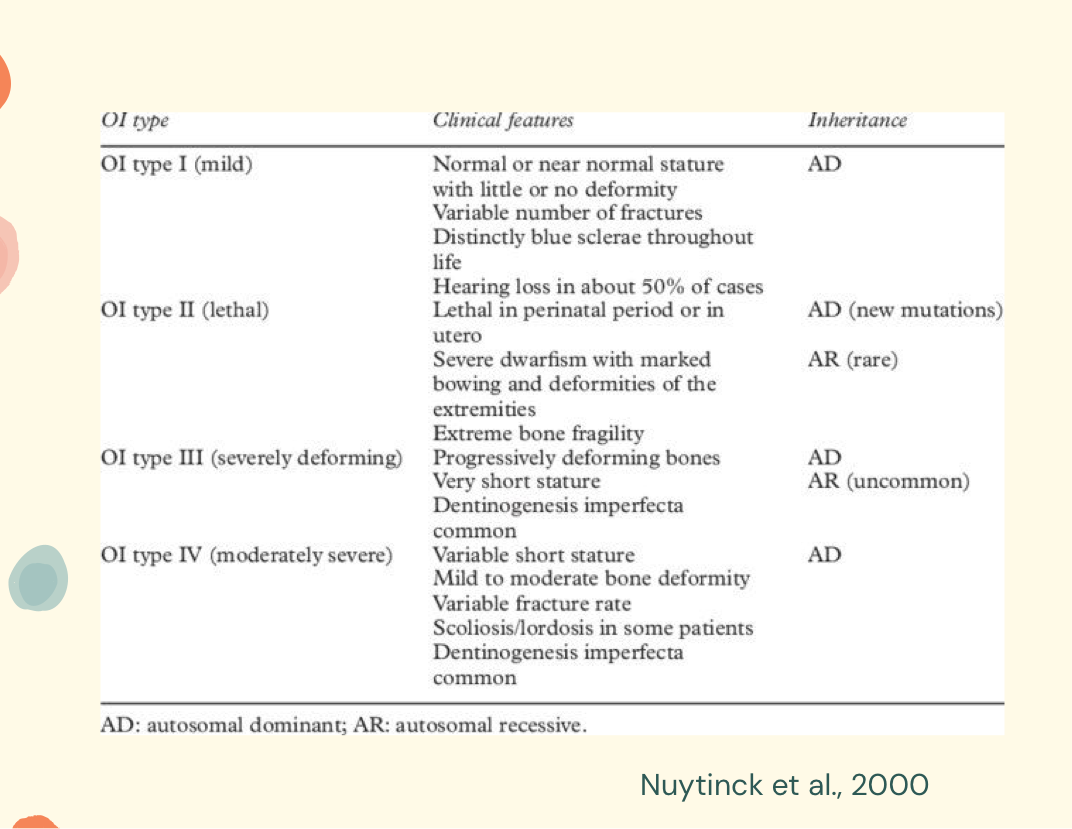Osteogenesis Imperfecta
1/23
There's no tags or description
Looks like no tags are added yet.
Name | Mastery | Learn | Test | Matching | Spaced |
|---|
No study sessions yet.
24 Terms
Osteogenesis Imperfecta
_______ disorder of the ______ tissue
Incidence: ______
Severeal _______tive factors have been identified for OI
Often referred to as ______ bones dieases characterized by lax joints, weak muscles and diffuse _____porosis
Inherited disorder of the connective tissue
Or novel mutation
Incidence 1:10,000
Several causative factors have been identified for OI
Often referred to as brittle bones disease characterized by lax joints, weak muscles and diffuse osteoporosis
How many genetic types does OI have?
4
What genes does types I-IV affect?
COL1A1 and COL1A2
Encode for type I collagen
Does types of V-XXI have an type I collagen defect?
no
OI Type I:
____ to ____bone fragility with few to several
fractures
Little or no ___ malformation
Most fractures occur ____ puberty
____ birth height/weight
Muscle ____ness
Joint __xity
F___ feet
Dislocations and sprains
Average ____ expectancy
Associated with blue ____, _____face, and _____
hearing loss
Mild to moderate bone fragility with few to several
fractures
Little or no bone malformation
Most fractures occur before puberty
Normal birth height/weight
Muscle weakness
Joint laxity
Flat feet
Dislocations and sprains
Average life expectancy
Associated with blue sclera, triangle face, and conductive hearing loss
What is most severe form of OI?
Type II
Extreme bone fragility
OI Type II:
Most ____ form
Extreme ____ fragility
Not _____ with life
_% do not survive past 1 week
Most severe form
Extreme bone fragility
Not compatible with life
80% do not survive past 1 week
OI Type III:
Often ____somal dominant
rarely _____
______re presentation
Progressive de____ of long bones, skull, and spine
____stature
Dentino____ im____ ___%
_____ loss common
Kypho____ severe
May result in _____tory comprise
Often autosomal dominant
rarely recessive
Severe presentation
Progressive deformity of long bones, skull, and spine
short stature
Dentinogenesis imperfecta 45%
hearing loss common
Kyphoscoliosis severe
May result in respiratory comprise
OI Type IV:
Mild to moderate bone ____ilty
____ bone deformity
Dentino____ im____ - common
Variable ____ loss
Prognosis for ambulation is ____
Mild to moderate bone fragility
Long bone deformity
Dentinogenesis imperfecta - common
Variable hearing loss
Prognosis for ambulation is excellent
REVIEW THIS CHART

OI Diagnosis:
____ manifestations
____ biopsy
ID ____ defect or mutation present
X-rays and bone scans
show evidence of multiple old ____ and skeletal ____
Clinical manifestations
Skin biopsy
ID collagen defect or mutation present
X-rays and bone scans
show evidence of multiple old fractures and skeletal deformities
Is there a cure for OI?
No
Medical Management of OI:
____ _____ vibration- being researched to increase bone density and strength
____ _____with intramedullary rods
Femur is best done after ____-___ y/o
_____ rods can be used to grow with patients
Complications with rotation and migration of rods ○
Early WB with orthotic support ASAP after surgery
____ deformities (50%)
____ not usually recommended for scoliosis/kyphosis
Whole body vibration- being researched to increase bone density and strength
Internal fixation with intramedullary rods
Femur is best done after 4-5 y/o
telescoping rods can be used to grow with patients
Complications with rotation and migration of rods ○
Early WB with orthotic support ASAP after surgery
Spinal deformities (50%)
Bracing not usually recommended for scoliosis/kyphosis
What kind of fractures may comprise respiratory and neural status?
Rib and skull fractures
Look over infacy slide (SLIDE 57)
LOOK AT INTERVENTION SLIDES
LOOK OVZER